Arctic Route Planning and Navigation Strategy: The Perspective of Ship Fuel Costs and Carbon Emissions
Abstract
1. Introduction
- Application of route planning method based on superposition field environment
- 2.
- No-navigation zone setting and route adjustment considering ship safety
- 3.
- Arctic navigation strategy design considering navigation distance
2. Materials and Methods
2.1. Field of Ice Condition
2.2. Field of Energy Consumption and Emission
2.3. Directional Field
2.4. Gradient Descent Path Search Algorithm Based on Superposition Field
2.4.1. The Superposition of Fields
2.4.2. Path Search Algorithm Based on Superposition Field
| Algorithm 1. Path planning |
| Input: Gradient of field Output: Trajectory of the ship (x) 1: 2: 3: Calculate initial ice condition factor, fuel cost and emissions after normalization: , and 4: Calculate initial directional field energy after normalization: 5: Calculate initial superimposition field energy: = 6: Procedure: 7: for do 8: Calculate initial ice condition factor, fuel cost and emissions after normalization: , and 9: Calculate initial directional field energy after normalization: 10: Calculate initial superimposition field energy: = 11: = U; 12: while do 13: 14: end while 15: 16: 17: end for 18: Repeat procedure |
3. Results and Discussion
3.1. Experimental Design
- (1)
- Select the ice-resistant class of vessels and analyze their navigational environment in different months according to the research data;
- (2)
- Determine the navigational restrictions for the class of vessels and delineate their no-navigation zones;
- (3)
- Path planning based on the principle of decreasing gradient in the superposition field environment;
- (4)
- Statistics of the fuel consumption cost and emission of different routes.
3.2. Experimental Results and Analysis
3.3. Model Validation and Analysis
4. Shipping Strategy Design
5. Conclusions
Author Contributions
Funding
Institutional Review Board Statement
Informed Consent Statement
Data Availability Statement
Conflicts of Interest
References
- Hsieh, T.-H.; Wang, S.; Gong, H.; Liu, W.; Xu, N. Sea Ice Warning Visualization and Path Planning for Ice Navigation Based on Radar Image Recognition. J. Mar. Sci. Technol. 2021, 29, 280–290. [Google Scholar] [CrossRef]
- Theocharis, D.; Pettit, S.; Rodrigues, V.S.; Haider, J. Arctic Shipping: A Systematic Literature Review of Comparative Studies. J. Transp. Geogr. 2018, 69, 112–128. [Google Scholar] [CrossRef]
- Zhang, Q.; Wan, Z.; Hemmings, B.; Abbasov, F. Reducing Black Carbon Emissions from Arctic Shipping: Solutions and Policy Implications. J. Clean. Prod. 2019, 241, 118261. [Google Scholar] [CrossRef]
- Furuichi, M.; Otsuka, N. Cost Analysis of the Northern Sea Route (NSR) and the Conventional Route Shipping. In Proceedings of the IAME 2013 Conference, Marseille, France, 4 July 2013. [Google Scholar]
- Choi, M.; Chung, H.; Yamaguchi, H.; Nagakawa, K. Arctic Sea Route Path Planning Based on an Uncertain Ice Prediction Model. Cold Reg. Sci. Technol. 2015, 109, 61–69. [Google Scholar] [CrossRef]
- Wang, Y.; Zhang, R.; Qian, L. An Improved A* Algorithm Based on Hesitant Fuzzy Set Theory for Multi-Criteria Arctic Route Planning. Symmetry 2018, 10, 765. [Google Scholar] [CrossRef]
- Lee, H.-W.; Roh, M.-I.; Kim, K.-S. Ship Route Planning in Arctic Ocean Based on POLARIS. Ocean Eng. 2021, 234, 109297. [Google Scholar] [CrossRef]
- Chang, K.Y.; He, S.S.; Chou, C.C.; Kao, S.L.; Chiou, A.S. Route Planning and Cost Analysis for Travelling through the Arctic Northeast Passage Using Public 3D GIS. Int. J. Geogr. Inf. Sci. 2015, 29, 1375–1393. [Google Scholar] [CrossRef]
- Zhang, M.; Zhang, D.; Fu, S.; Yan, X.; Zhang, C. A Method for Planning Arctic Sea Routes under Multi-Constraint Conditions. In Proceedings of the International Conference on Port and Ocean Engineering under Arctic Conditions, POAC, Busan, Republic of Korea, 1 January 2017. [Google Scholar]
- Zhang, C.; Zhang, D.; Zhang, M.; Mao, W. Data-Driven Ship Energy Efficiency Analysis and Optimization Model for Route Planning in Ice-Covered Arctic Waters. Ocean Eng. 2019, 186, 106071. [Google Scholar] [CrossRef]
- Topaj, A.G.; Tarovik, O.V.; Bakharev, A.A.; Kondratenko, A.A. Optimal Ice Routing of a Ship with Icebreaker Assistance. Appl. Ocean Res. 2019, 86, 177–187. [Google Scholar] [CrossRef]
- Hollenbach, U.; Friesch, J. Efficient Hull Forms—What Can Be Gained? In Proceedings of the 1st International Conference on Ship Efficiency, Hamburg, Germany, 23–24 September 2013. [Google Scholar]
- Prpić-Oršić, J.; Faltinsen, O.M. Estimation of Ship Speed Loss and Associated CO2 Emissions in a Seaway. Ocean Eng. 2012, 44, 1–10. [Google Scholar] [CrossRef]
- Huang, L.; Li, Z.; Ryan, C.; Ringsberg, J.W.; Pena, B.; Li, M.; Ding, L.; Thomas, G. Ship Resistance When Operating in Floating Ice Floes: Derivation, Validation, and Application of an Empirical Equation. Mar. Struct. 2021, 79, 103057. [Google Scholar] [CrossRef]
- Wu, P.; Xie, S.; Liu, H.; Li, M.; Li, H.; Peng, Y.; Li, X.; Luo, J. Autonomous Obstacle Avoidance of an Unmanned Surface Vehicle Based on Cooperative Manoeuvring. Ind. Robot Int. J. 2017, 44, 64–74. [Google Scholar] [CrossRef]



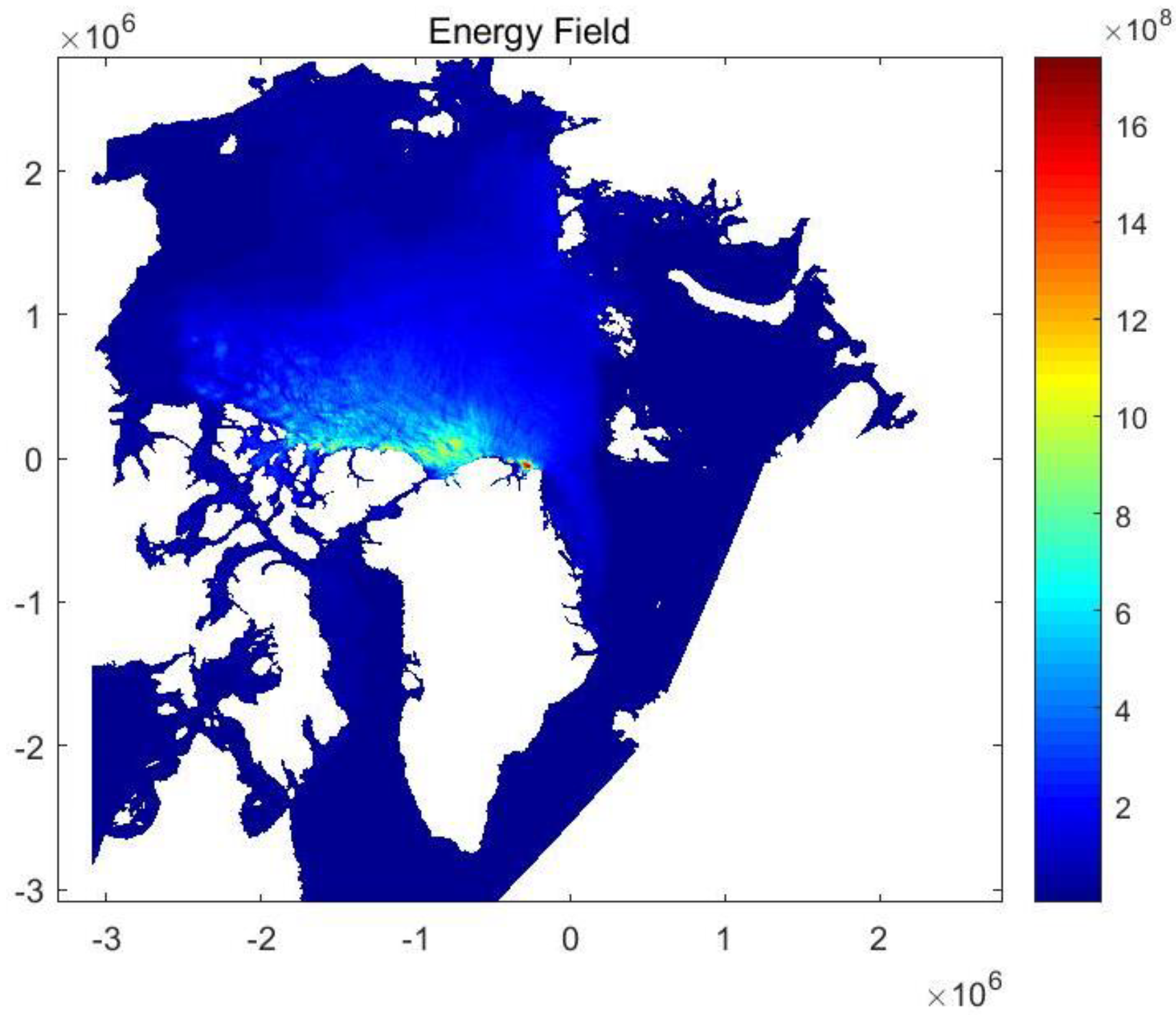
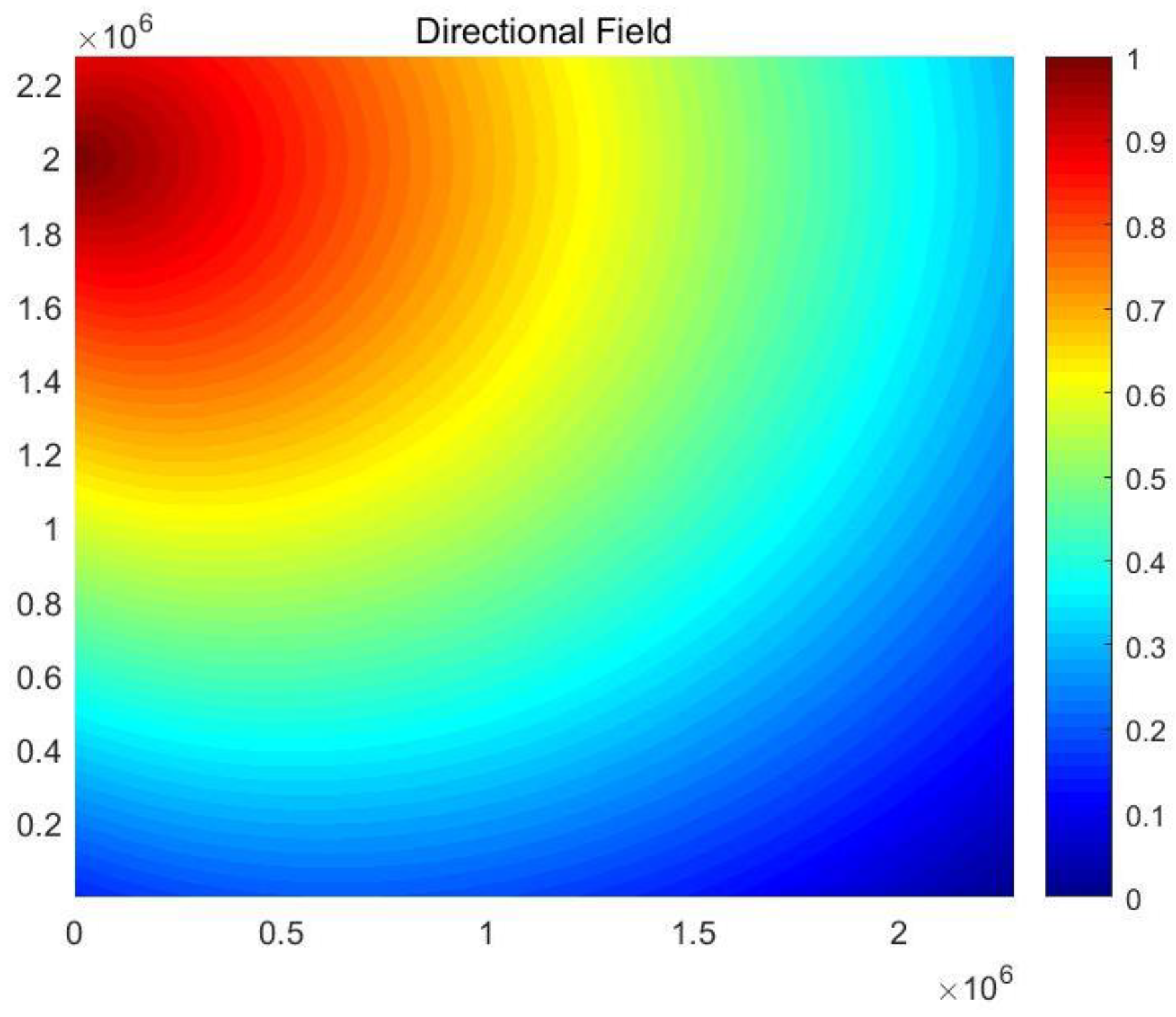
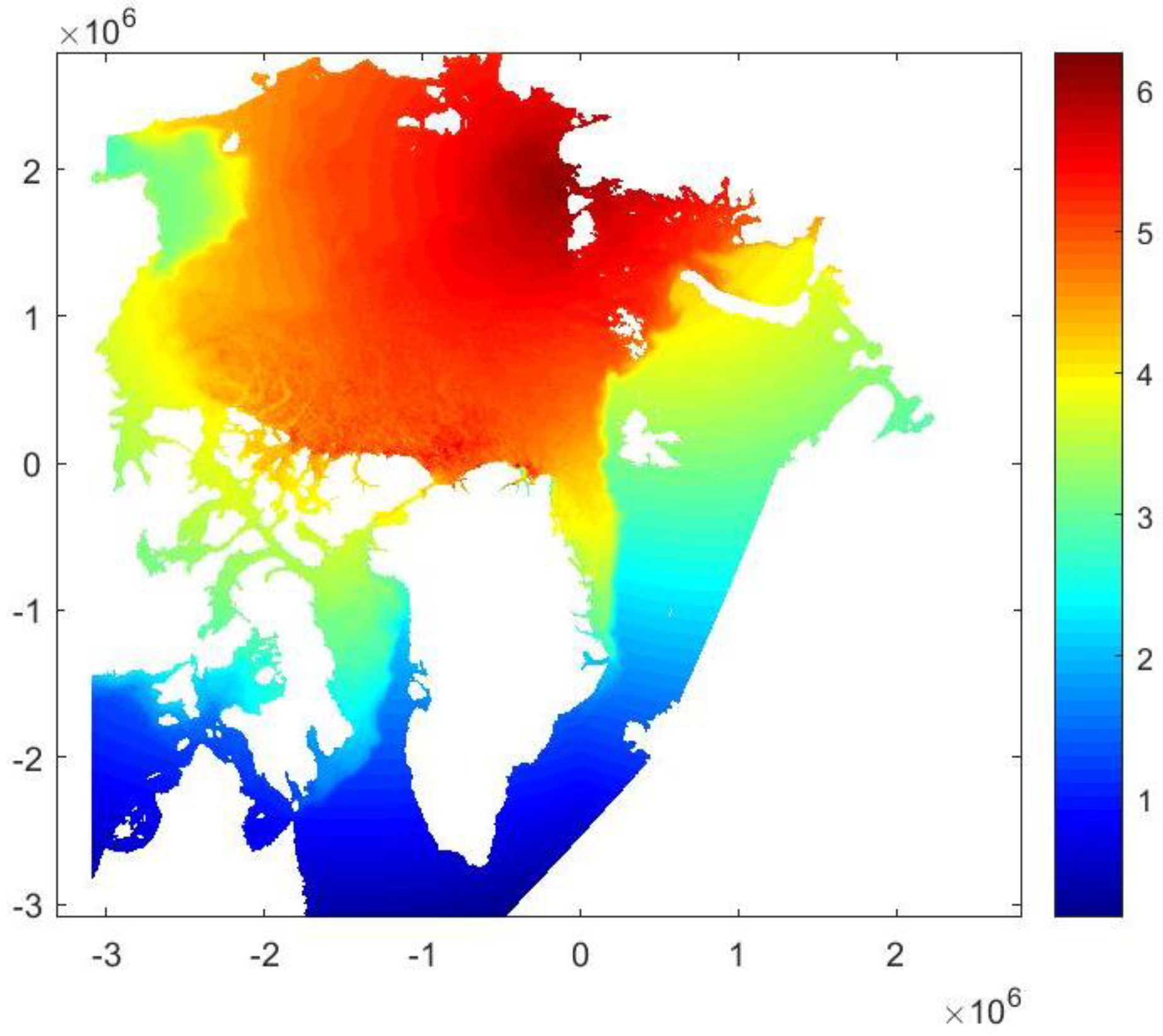
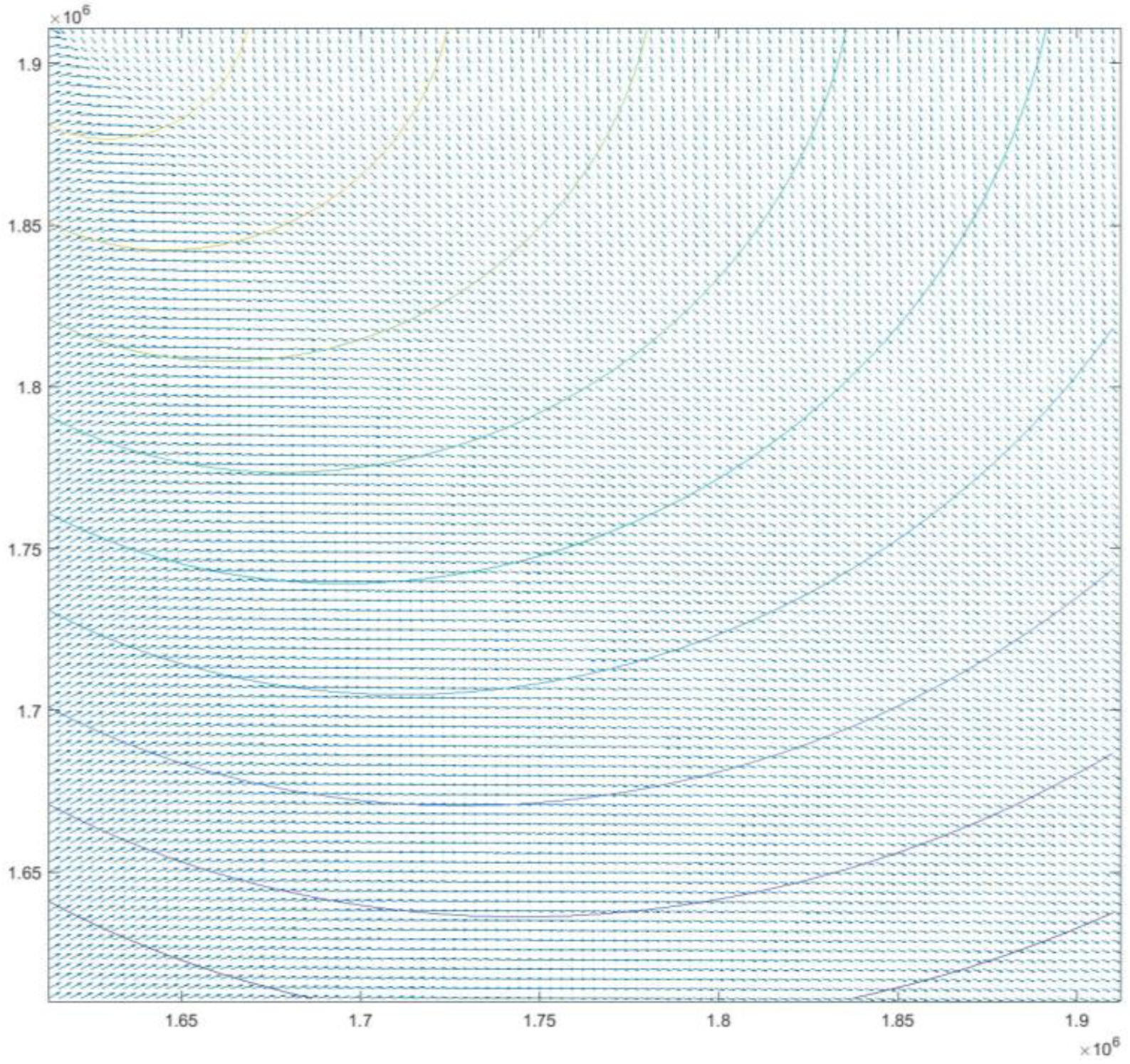
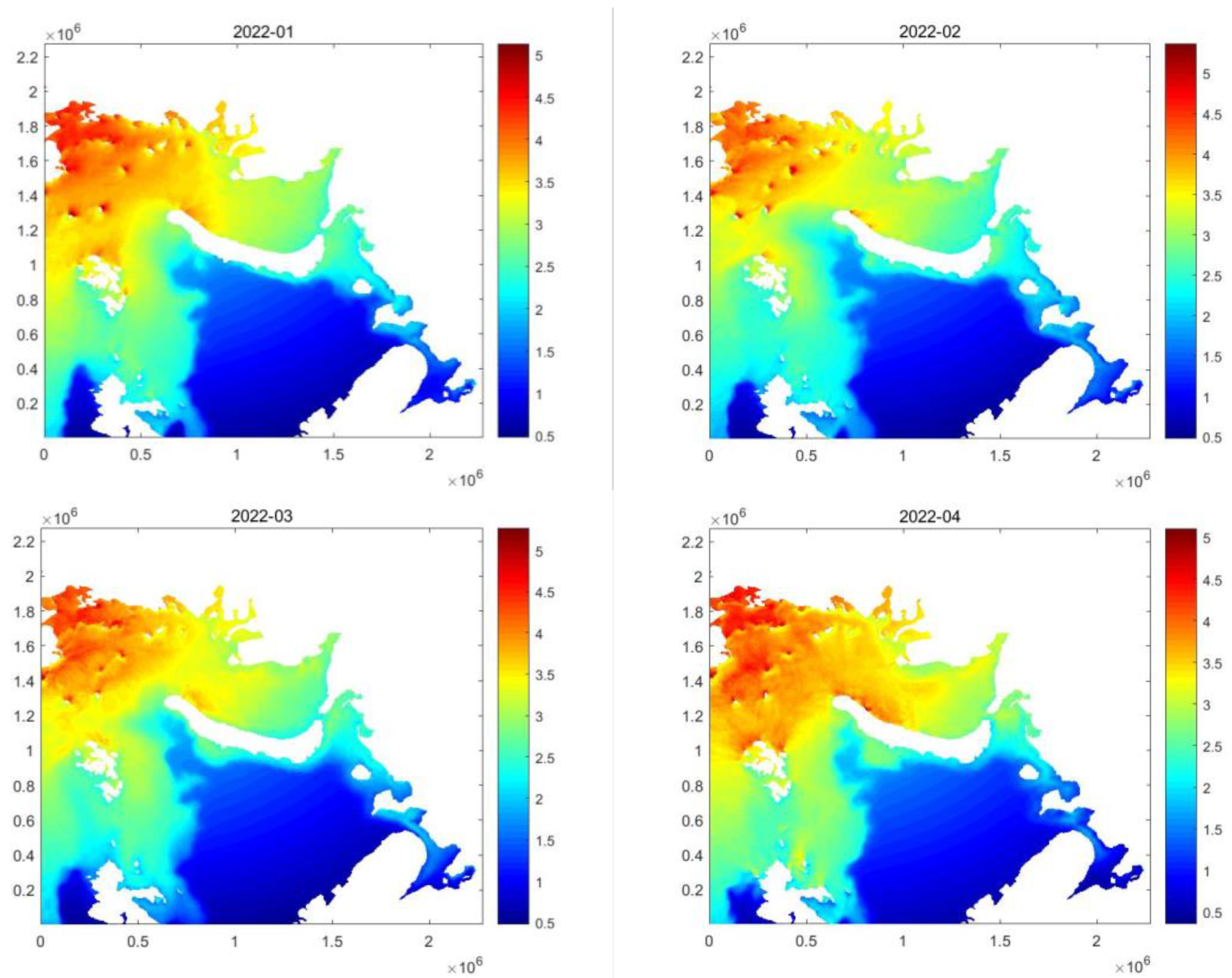
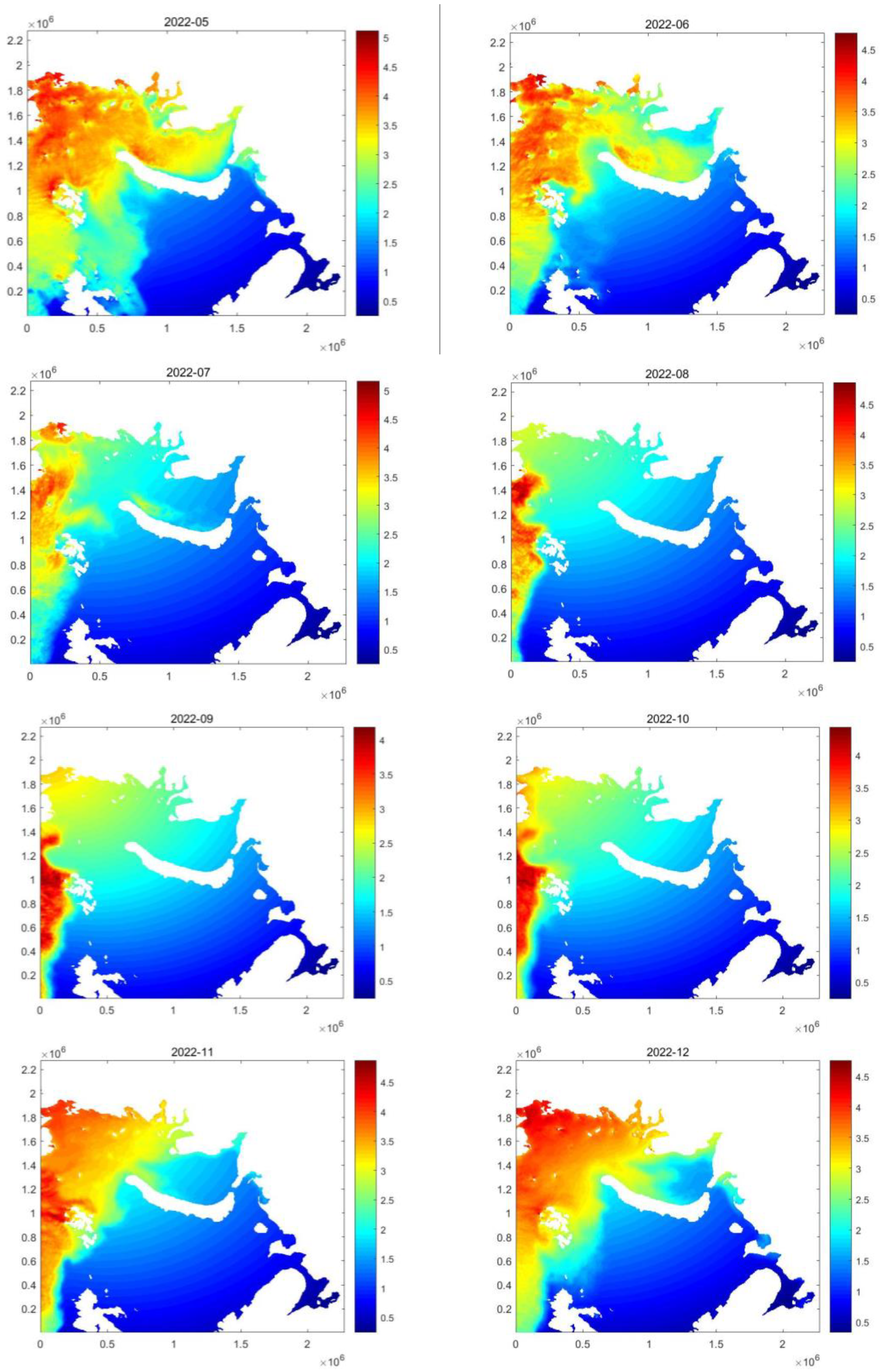
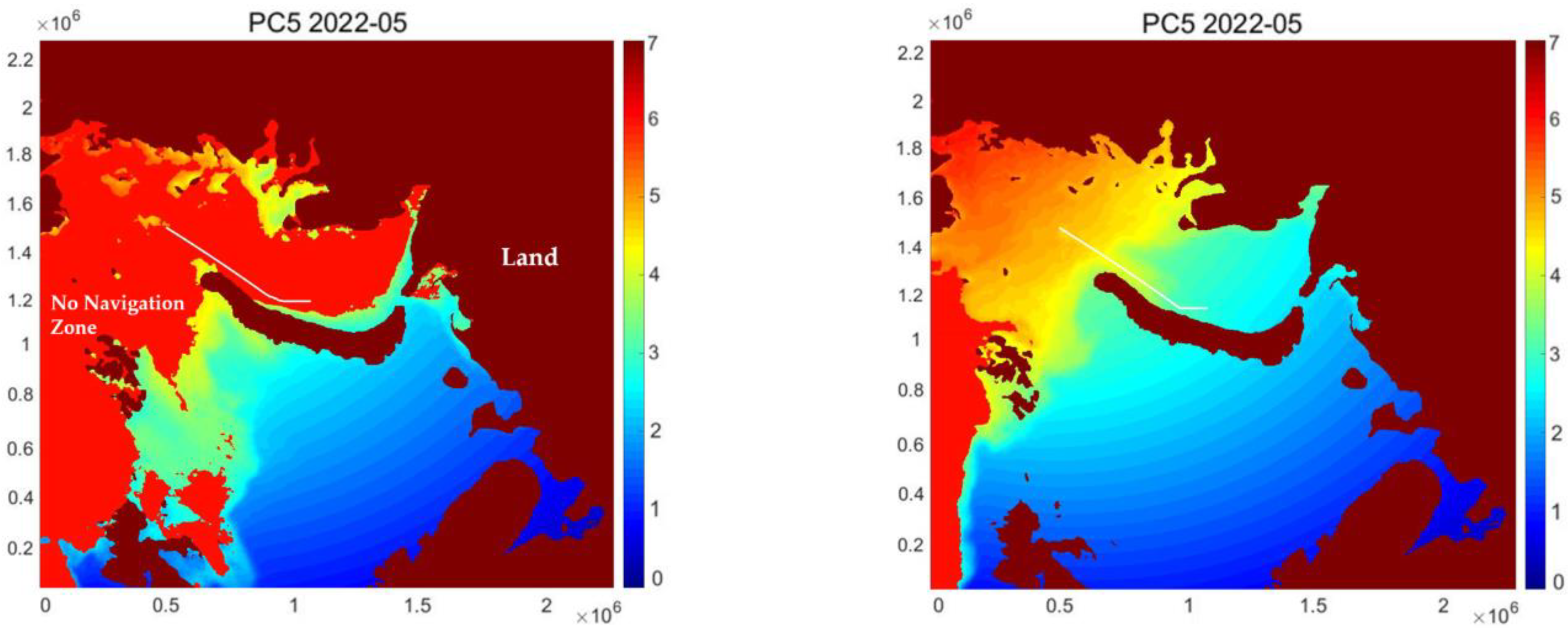


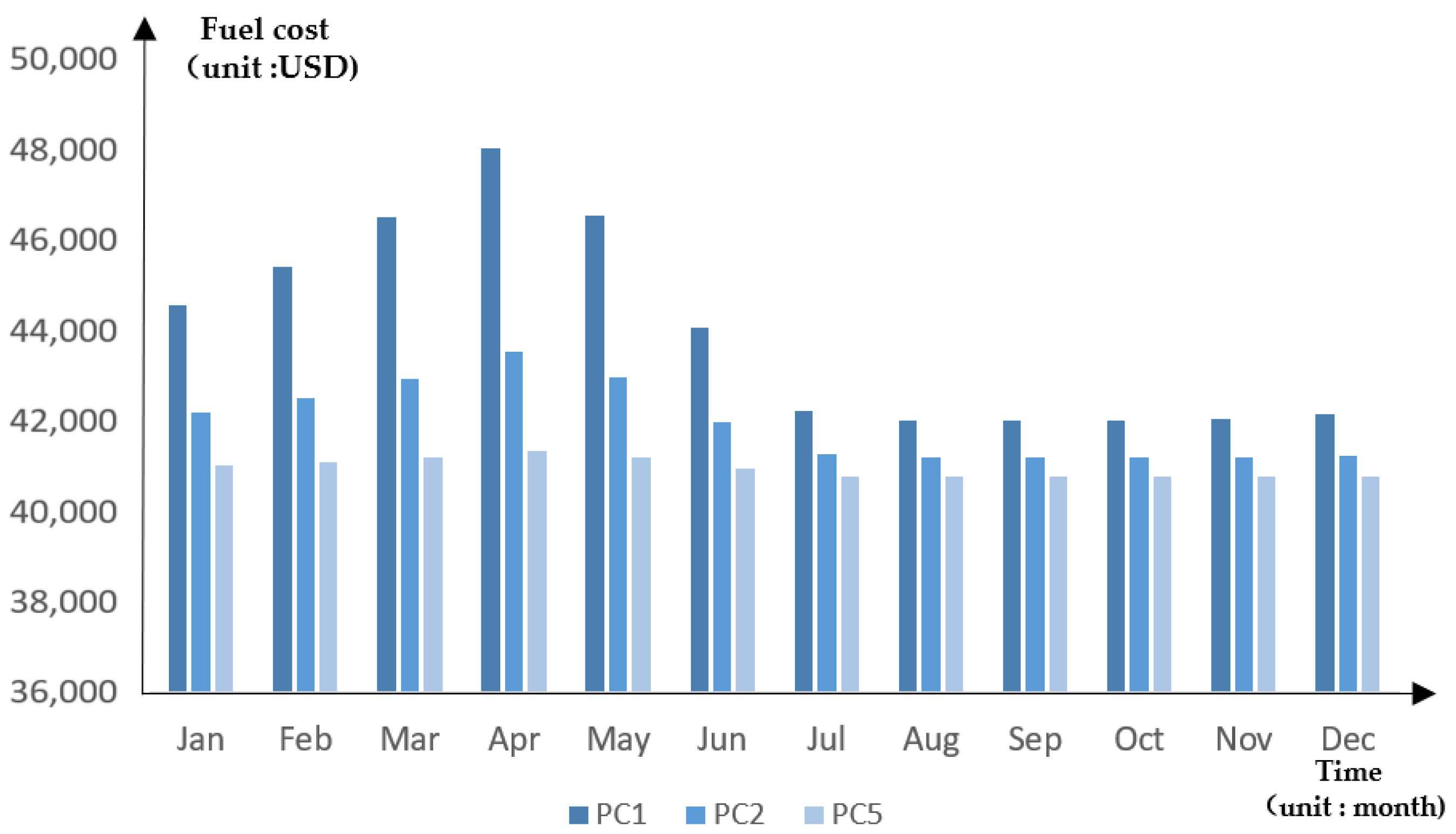
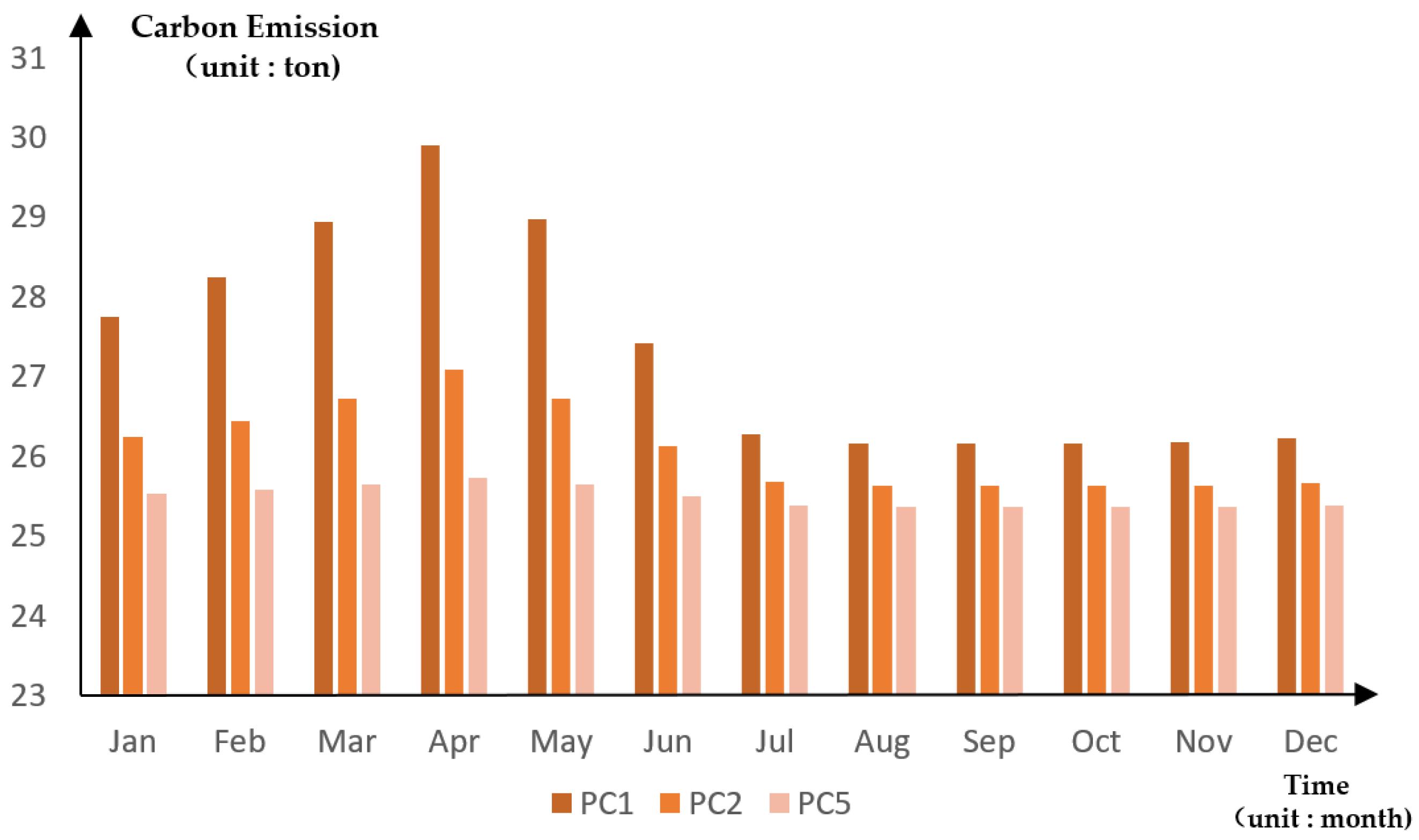

| Ice Concentration | Description | Navigability |
|---|---|---|
| 0/10 | Ice-free | Freely Navigable |
| <1/10 | Open Water | |
| 1/10–3/10 | Very Open Drift | Cannot Navigate in the Scheduled Direction |
| 4/10–6/10 | Open Drift | Obstacles to Navigation |
| 7/10–8/10 | Close Pack | |
| 9/10 | Very Close Pack | Hard to Navigate Independently without Ice Breaker Support |
| * 9/10 | Compact Ice | |
| 10/10 | Consolidated Ice |
| Ice Class | Operating Capability |
|---|---|
| PC1 | Year-round Operation in all polar water |
| PC2 | Year-round Operation in moderate multi-year ice |
| PC3 | Year-round Operation in second-year ice which may include multi-year inclusions |
| PC4 | Year-round Operation in thick first-year ice which may include old ice inclusions |
| PC5 | Year-round Operation in medium first-year ice which may include old ice inclusions |
| PC6 | Summer/Autumn Operation in medium first-year ice which may include old ice inclusions |
| PC7 | Summer/Autumn Operation in thin first-year ice which may include old ice inclusions |
| Stage of Development | Ice Thickness |
|---|---|
| Multi-Year Ice | 2~4 m |
| Second-Year Ice | 2 m or more |
| First-Year Ice | 30~120 cm |
| Thin First-Year Ice | 30~70 cm |
| Medium First-Year Ice | 70~120 cm |
| Thick First-Year Ice | ≥120 cm |
| Parameters | Meaning |
|---|---|
| Still water power | |
| Water density | |
| Still water drag coefficient | |
| Wetted surface | |
| Ship speed | |
| Cargo on board the vessel | |
| Cargo weight constant | |
| Dead weight tonnage | |
| Ship resistance induced by ice | |
| Ice resistance coefficient | |
| Ice density | |
| Equivalent ice diameter of upper surface | |
| Ship beam at waterline | |
| Ship length between perpendiculars | |
| Froude number |
| Parameter | PC1 | PC2 | PC5 |
|---|---|---|---|
| (kts) | 11 | 8 | 5 |
| DWT (t) | 1000 | 1000 | 1000 |
| 10 | 10 | 10 | |
| 1 | 1 | 1 | |
| B | 30 | 31 | 32 |
Disclaimer/Publisher’s Note: The statements, opinions and data contained in all publications are solely those of the individual author(s) and contributor(s) and not of MDPI and/or the editor(s). MDPI and/or the editor(s) disclaim responsibility for any injury to people or property resulting from any ideas, methods, instructions or products referred to in the content. |
© 2023 by the authors. Licensee MDPI, Basel, Switzerland. This article is an open access article distributed under the terms and conditions of the Creative Commons Attribution (CC BY) license (https://creativecommons.org/licenses/by/4.0/).
Share and Cite
Chen, A.; Chen, W.; Zheng, J. Arctic Route Planning and Navigation Strategy: The Perspective of Ship Fuel Costs and Carbon Emissions. J. Mar. Sci. Eng. 2023, 11, 1308. https://doi.org/10.3390/jmse11071308
Chen A, Chen W, Zheng J. Arctic Route Planning and Navigation Strategy: The Perspective of Ship Fuel Costs and Carbon Emissions. Journal of Marine Science and Engineering. 2023; 11(7):1308. https://doi.org/10.3390/jmse11071308
Chicago/Turabian StyleChen, Aowen, Weiqi Chen, and Jian Zheng. 2023. "Arctic Route Planning and Navigation Strategy: The Perspective of Ship Fuel Costs and Carbon Emissions" Journal of Marine Science and Engineering 11, no. 7: 1308. https://doi.org/10.3390/jmse11071308
APA StyleChen, A., Chen, W., & Zheng, J. (2023). Arctic Route Planning and Navigation Strategy: The Perspective of Ship Fuel Costs and Carbon Emissions. Journal of Marine Science and Engineering, 11(7), 1308. https://doi.org/10.3390/jmse11071308





